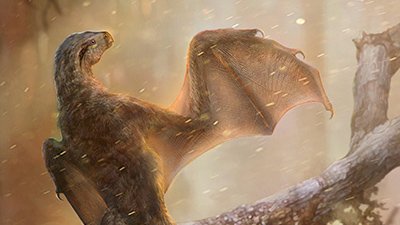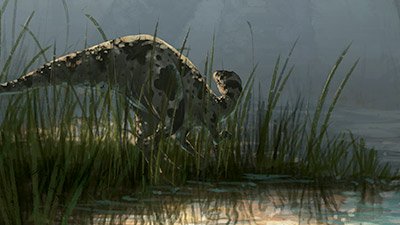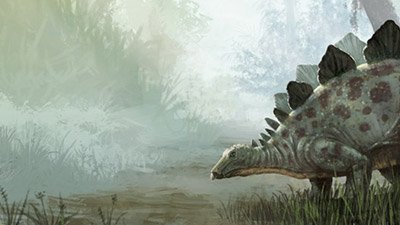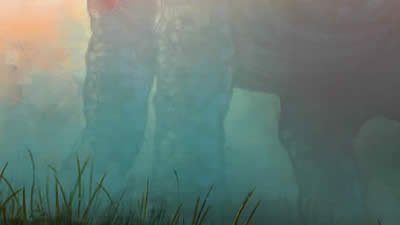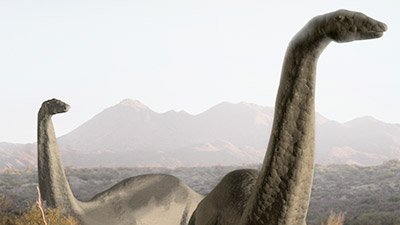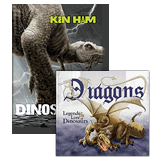Types of Dinosaurs
Hypsilophodon
Hypsilophodon foxii was one of the first dinosaurs discovered. This small, plant-eating animal was first discovered in 1849, a mere seven years after Sir Richard Owen coined the term dinosaur.
T. rex
Tyrannasaurus rex, first described in 1905, this “tyrant lizard king” still holds the crown as the largest and most fearsome terrestrial predator ever discovered in North America. Since T. rex is found only in Flood deposits, our knowledge of this great animal is limited to his fossilized remains.
Sauropods
The sauropods (“lizard feet”) included the largest land animals in history. With fossils on every continent, sauropods are easily recognized by their extremely long necks and tails, which are anchored to a huge body and held up by towering legs. How do you support and move all that bulk?
Albertaceratops
A newly uncovered dinosaur, Albertaceratops nesmoi, had horns about three–feet long (located right above its eyebrows). In the evolutionists’ timeline, dinosaurs that were older than this one had larger horns, and the ones that followed had smaller horns. Hence, evolutionists say, this creature represents a middle step.
News About Types of Dinosaurs
-
May 9, 2019 from Ken Ham Blog
Headlines around the world are announcing the discovery of a new species of “bat-wing dinosaur” uncovered in China. But what was this creature?
Articles About Types of Dinosaurs
-
March 17, 2019 from Answers Magazine
In all the hoopla about the really big dinosaurs, the little ones get forgotten.
-
March 10, 2019 from Answers Magazine
Contrary to popular portrayals of T. Rex as an ungainly brute who lumbered onto the scene millions of years ago, he was regally designed.
-
Oct. 16, 2018 from Answers in Depth
Ichthyosaurus is well studied, and research on their skeletons has provided evidence for incredible design and the global flood.
-
In-Depth ArticleTriassic Fossil Said to be a Transitional IchthyosaurNov. 8, 2014 from Answers in Depth
Did ancient ichthyosaurs march from land to sea in Triassic China?
-
Sept. 18, 2014 from Answers in Depth
Massive Dreadnoughtus said to shed light on the evolution of gigantism.
-
In-Depth ArticleMercuriceratops Delivers a Message from the PastJune 28, 2014 from Answers in Depth
Does Mercuriceratops, like its mythological namesake messenger of the gods, bring us a mythological message from an evolutionary past?
-
In-Depth ArticleArctic Tyrannosaur Takes the Prize for Being PetiteApril 3, 2014 from Answers in Depth
Dinosaur skull changes the face of tyrannosaurus expectations and leads to speculation about ancient Arctic animal populations.
-
In-Depth ArticleDuck-billed Dinosaur's Cranial Crest Has Paleontologists CrowingJan. 2, 2014 from Answers in Depth
The paleontologist who found the crested duck-billed dinosaur was correct that preservation of soft tissue demands special conditions: rapid burial.
-
Baby Parasaurolophus Crest Joined the Chorus EarlyNov. 11, 2013 from News to Know
If a Parasaurolophus daddy sang bass, little brother was able to join right in there.
-
New Tyrannosaur Pushes Back Evolutionary TimelineNov. 9, 2013 from News to Know
Remarkably advanced tyrannosaur too low on the evolutionary staircase complicates dinosaur lineage.
-
Dino-Mom and EggApril 21, 2012 from News to Know
Catastrophically buried together thousands of years ago, dino-mom and eggs come to light.
-
Dino BabiesJan. 28, 2012 from News to Know
“The sound of little prehistoric feet tells the story” but not necessarily the story some think!
-
Toy T-rex 2.0Jan. 22, 2011 from News to Know
Is a tiny dinosaur called Eodromaeus the predecessor to big beasts like T. rex?
-
Hybrid DinosaurOct. 16, 2010
T. rex is one of the best-known dinosaurs, and among the things T. rex is known for are its almost humorously short, weak arms. Many herbivorous dinosaurs, meanwhile, had four powerful legs but no arms. But a newly discovered dinosaur appears to have been something of a hybrid: it stood on only two hind legs, like T. rex, but sported arms with powerful hands.
-
-
July 1, 2010 from Answers Magazine
The discovery of dinosaur fossils in Antarctica forces us to ask what extreme changes caused heat-loving dinosaurs to wind up on this ice-covered continent.
-
Dinosaur Ancestors Alive Earlier than Originally ThoughtMarch 6, 2010 from News to Know
A new fossil discovery tells evolutionists that some of dinosaurs’ supposed ancestors were on the scene ten million years earlier than was thought. What does the find tell creationists?
-
Jan. 1, 2010 from Answers Magazine
The biggest of dinosaurs were some of the long-neck sauropods.
-
Dinosaur ApemanNov. 21, 2009 from News to Know
We typically think of the “missing link” as an ape–human transitional form. In this case, though, the “missing link” is “big, short-footed, barrel-chested, long-necked, small-headed dinosaur.”
-
Meet LeviathanOct. 31, 2009 from News to Know
Was the skull of an ancient Leviathan found in Dorset?
-
Toy T. rexSept. 26, 2009 from News to Know
Would a miniature T. rex be any less frightening than the real thing?
-
Tree-Climbing VelociraptorsSept. 19, 2009 from News to Know
Velociraptor: the fearsome carnivore and . . . tree climber?
-
Mini T-rex AncestorApril 25, 2009 from News to Know
A fossil dinosaur found in China—the great great granddaddy of fearsome T. rex?
-
Polar DinosaursOct. 17, 2008
What do dinosaur bones found in the far north of Alaska say about the creatures?
-
A Vegetarian Dinosaur's Big MouthOct. 6, 2007 from News to Know
Researchers are confused as to what a giant, duck-billed, many-toothed dinosaur would eat.
-
T. rex: Life in the Slow LaneJune 9, 2007
New research suggests that tyrannosaurus rexes were quite slow.
-
Paleontologists Find Medium-Horned Dinosaur, EcstaticMarch 10, 2007
Evolutionary scientists were excited when they discovered a dinosaur with medium-sized horns.
-
On the horns of a dilemma?March 6, 2007
How do creationists respond to evolutionists who tout “evolution actually works” with the newest dinosaur find?
-
Feb. 27, 2007 from Answers Magazine
Based on what we have found so far in the fossil record, sauropods were likely the largest family of land creatures ever to walk the earth.
-
Dinosaurs: Phylogenetic ChartJuly 2, 1998
Take a look at the fine print. Notice where it says that the “tinted” areas indicate “solid” fossil evidence.
-
Dinosaurs Whipped Mates into Line?March 11, 1998
In 1989, the biomechanics expert R. McNeill Alexander proposed that Sauropods may have used their tails as whips.
-
Magazine ArticleIchthyosaurs—Created to Live in the SeaMarch 1, 1996, pp. 14–15
The origin of marine reptiles is a particular problem for evolution, for evolutionists claim that these reptiles have actually gone from the land back into the water.
Recommended Resources

Answers in Genesis is an apologetics ministry, dedicated to helping Christians defend their faith and proclaim the good news of Jesus Christ.
- Customer Service 800.778.3390
- © 2024 Answers in Genesis


